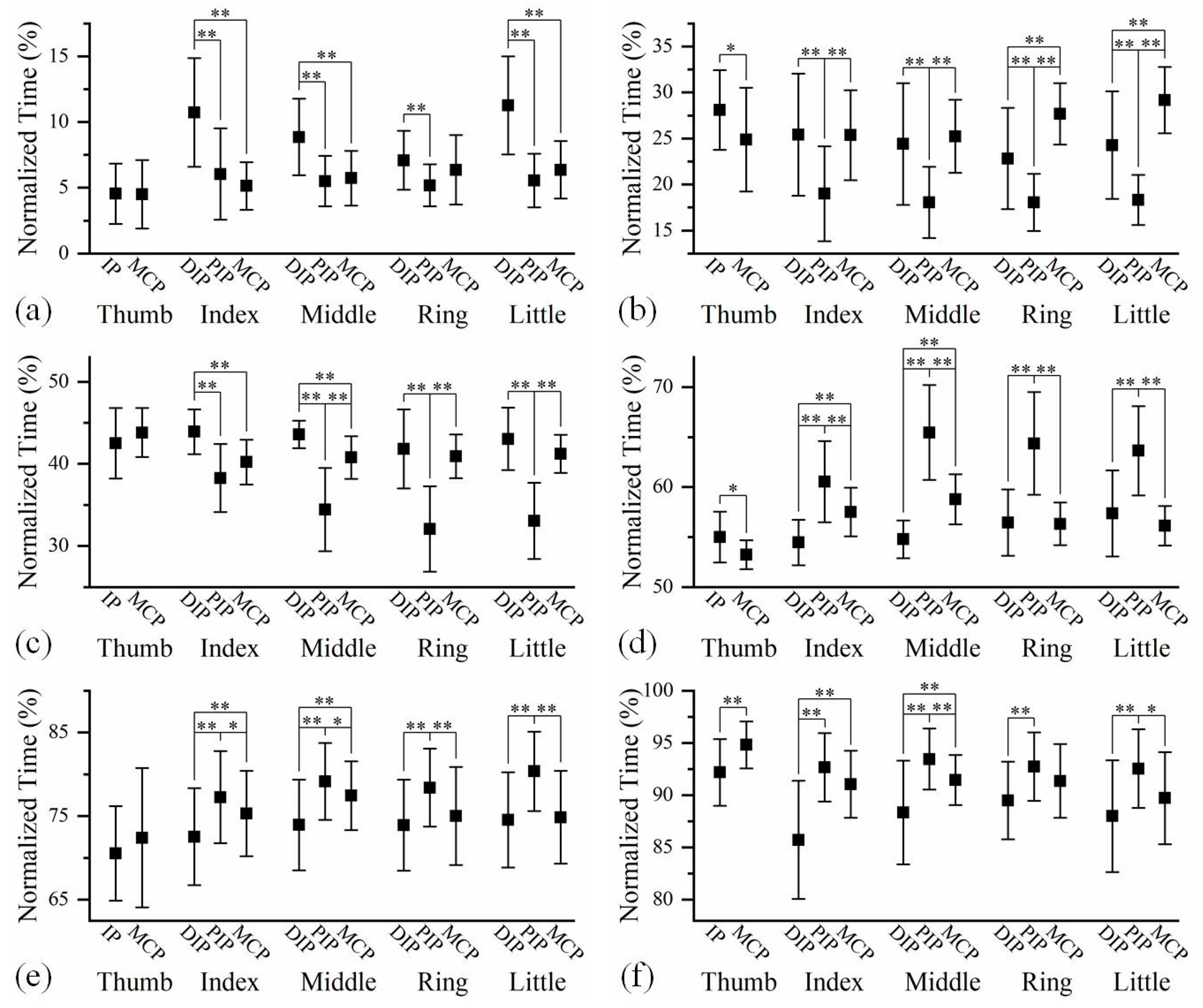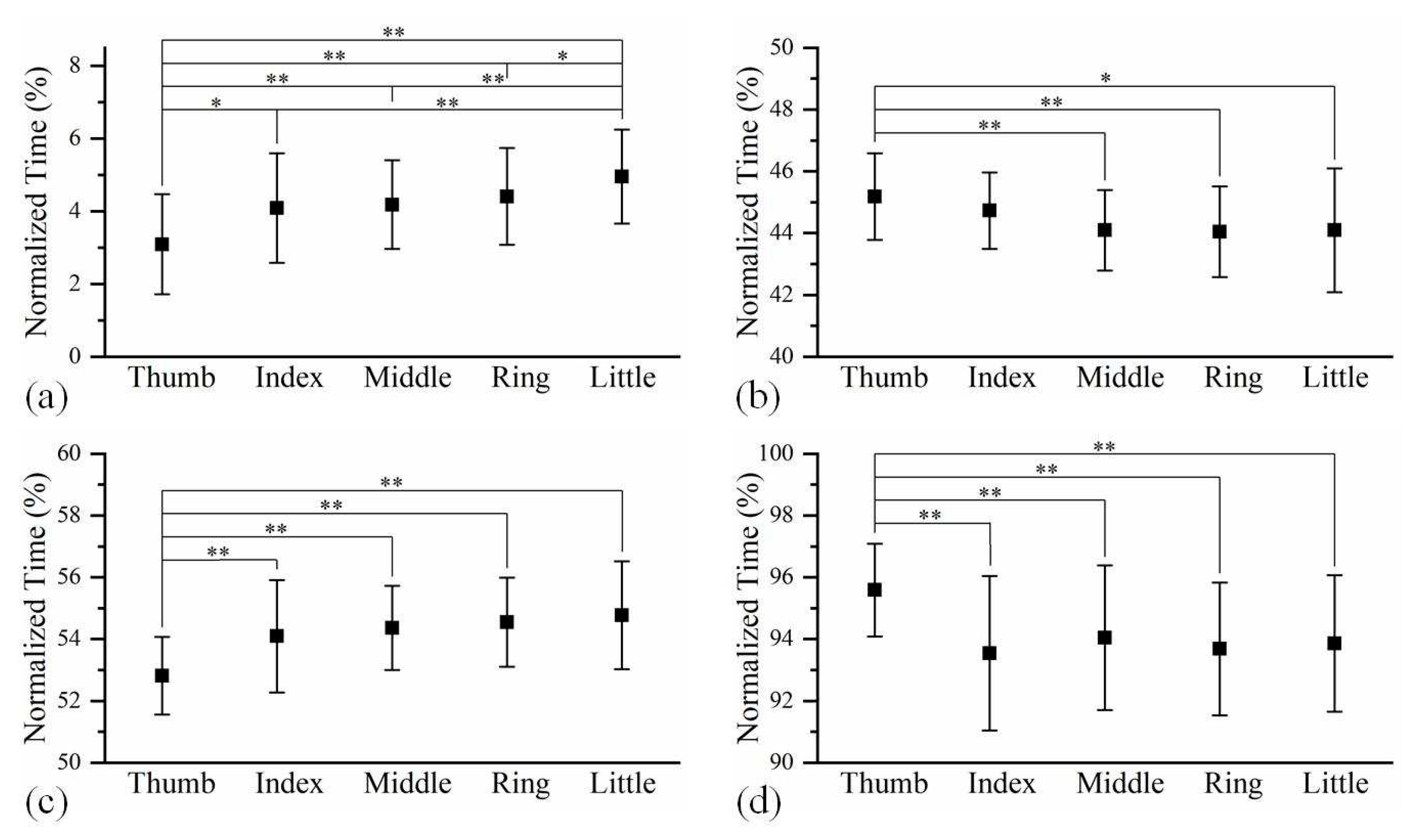Submitted:
23 April 2023
Posted:
23 April 2023
You are already at the latest version
Abstract
Keywords:
1. Introduction
2. Materials and Methods
2.1. Participants
2.2. Procedures
2.3. Measures
2.4. Statistical Analysis
3. Results
3.1. Dynamic ROM
3.2. Peak Velocity
3.3. Joint Sequence
3.4. Finger Sequence
4. Discussion
5. Conclusions
Author Contributions
Funding
Conflicts of Interest
References
- Sobinov, A.R.; Bensmaia, S.J. The neural mechanisms of manual dexterity. Nat. Rev. Neurosci. 2021, 22, 741–757. [Google Scholar] [CrossRef] [PubMed]
- Bensmaia, S.J.; Tyler, D.J.; Micera, S. Restoration of sensory information via bionic hands. Nat. Biomed. Eng. 2020, 1–13. [Google Scholar] [CrossRef]
- Piazza, C.; Grioli, G.; Catalano, M.; Bicchi, A.J.A.R.o.C., Robotics; Systems, A. A century of robotic hands. Annu. Rev. Control Rob. Auton. Syst. 2019, 2, 1–32. [Google Scholar] [CrossRef]
- Okada, T. Computer control of multijointed finger system for precise object-handling. IEEE Trans. Syst. Man Cybern. 1982, 12, 289–299. [Google Scholar] [CrossRef]
- Jacobsen, S.; Iversen, E.; Knutti, D.; Johnson, R.; Biggers, K. Design of the Utah/MIT dextrous hand. In Proceedings of the 1986 IEEE International Conference on Robotics and Automation; 1986; pp. 1520–1532. [Google Scholar]
- Laffranchi, M.; Boccardo, N.; Traverso, S.; Lombardi, L.; Canepa, M.; Lince, A.; Semprini, M.; Saglia, J.A.; Naceri, A.; Sacchetti, R. The Hannes hand prosthesis replicates the key biological properties of the human hand. Sci. Rob. 2020, 5, eabb0467. [Google Scholar] [CrossRef] [PubMed]
- Wang, D.; Xiong, Y.; Zi, B.; Qian, S.; Wang, Z.; Zhu, W. Design, analysis and experiment of a passively adaptive underactuated robotic hand with linkage-slider and rack-pinion mechanisms. Mech. Mach. Theory 2021, 155, 104092. [Google Scholar] [CrossRef]
- Mohammadi, A.; Lavranos, J.; Zhou, H.; Mutlu, R.; Alici, G.; Tan, Y.; Choong, P.; Oetomo, D. A practical 3D-printed soft robotic prosthetic hand with multi-articulating capabilities. PLoS One 2020, 15, e0232766. [Google Scholar] [CrossRef]
- Gu, G.; Zhang, N.; Xu, H.; Lin, S.; Yu, Y.; Chai, G.; Ge, L.; Yang, H.; Shao, Q.; Sheng, X. A soft neuroprosthetic hand providing simultaneous myoelectric control and tactile feedback. Nat. Biomed. Eng. 2021, 1–10. [Google Scholar] [CrossRef] [PubMed]
- Gracia-Ibáñez, V.; Vergara, M.; Sancho-Bru, J.L.; Mora, M.C.; Piqueras, C. Functional range of motion of the hand joints in activities of the International Classification of Functioning, Disability and Health. J. Hand Ther. 2017, 30, 337–347. [Google Scholar] [CrossRef]
- Jarque-Bou, N.J.; Vergara, M.; Sancho-Bru, J.L.; Gracia-Ibáñez, V.; Roda-Sales, A. A calibrated database of kinematics and EMG of the forearm and hand during activities of daily living. Sci. Data 2019, 6, 270. [Google Scholar] [CrossRef] [PubMed]
- Padilla-Magaña, J.F.; Peña-Pitarch, E.; Sánchez-Suarez, I.; Ticó-Falguera, N. Quantitative assessment of hand function in healthy subjects and post-stroke patients with the action research arm test. Sensors 2022, 22, 3604. [Google Scholar] [CrossRef] [PubMed]
- Du, X. Atrophic cerebral peduncle may be a hallmark for evaluating the compensatory ability of the contralateral hemisphere. Journal of Neurorestoratology 2022, 10, 100024. [Google Scholar] [CrossRef]
- Guiwen, C.; Zhitao, P.; Yuanqiang, Z.; Xiaowen, L.; Li, Y.; Zhihao, Z.; Jiasheng, J.; Jianliang, C. Improved clinical symptoms in three patients with spinocerebellar ataxia through a surgical decompression procedure of the posterior cranial fossa with subsequent flap transplantation of the cerebellum. Journal of Neurorestoratology 2022, 10, 52–65. [Google Scholar] [CrossRef]
- Shahid, T.; Gouwanda, D.; Nurzaman, S.G.; Gopalai, A.A. Moving toward soft robotics: a decade review of the design of hand exoskeletons. Biomimetics 2018, 3, 17. [Google Scholar] [CrossRef] [PubMed]
- Vertongen, J.; Kamper, D.G.; Smit, G.; Vallery, H. Mechanical aspects of robot hands, active hand orthoses, and prostheses: a comparative review. IEEE ASME Trans. Mechatron. 2020, 26, 955–965. [Google Scholar] [CrossRef]
- Thayer, N.; Priya, S. Design and implementation of a dexterous anthropomorphic robotic typing (DART) hand. SmMaS 2011, 20, 035010. [Google Scholar] [CrossRef]
- Shirafuji, S.; Ikemoto, S.; Hosoda, K. Development of a tendon-driven robotic finger for an anthropomorphic robotic hand. Int. J. Robot. Res. 2014, 33, 677–693. [Google Scholar] [CrossRef]
- Kim, U.; Jung, D.; Jeong, H.; Park, J.; Jung, H.-M.; Cheong, J.; Choi, H.R.; Do, H.; Park, C. Integrated linkage-driven dexterous anthropomorphic robotic hand. Nature Communications 2021, 12, 7177. [Google Scholar] [CrossRef]
- Somia, N.; Rash, G.; Wachowiak, M.; Gupta, A. The initiation and sequence of digital joint motion: a three-dimensional motion analysis J. Hand Surg. Eur. Vol. 1998, 23, 792–795. [Google Scholar] [CrossRef]
- Holguín, P.H.; Rico, Á.A.; Gómez, L.P.; Munuera, L.M. The coordinate movement of the interphalangeal joints: a cinematic study. Clin. Orthop. Relat. Res. 1999, 362, 117–124. [Google Scholar]
- Braido, P.; Zhang, X. Quantitative analysis of finger motion coordination in hand manipulative and gestic acts. Hum. Mov. Sci. 2004, 22, 661–678. [Google Scholar] [CrossRef]
- Carpinella, I.; Jonsdottir, J.; Ferrarin, M. Multi-finger coordination in healthy subjects and stroke patients: a mathematical modelling approach. J. Neuroeng. Rehabil. 2011, 8, 1–20. [Google Scholar] [CrossRef] [PubMed]
- Mentzel, M.; Benlic, A.; Wachter, N.; Gulkin, D.; Bauknecht, S.; Gülke, J. The dynamics of motion sequences of the finger joints during fist closure. Handchir. Mikrochir. Plast. Chir. 2011, 43, 147–154. [Google Scholar] [CrossRef] [PubMed]
- Li, X.; Wen, R.; Shen, Z.; Wang, Z.; Luk, K.D.K.; Hu, Y. A wearable detector for simultaneous finger joint motion measurement. IEEE Tran. Biomed. Circ. S. 2018, 12, 644–654. [Google Scholar] [CrossRef]
- Ono, K.; Ebara, S.; Fuji, T.; Yonenobu, K.; Fujiwara, K.; Yamashita, K. Myelopathy hand. New clinical signs of cervical cord damage. J. Bone Joint Surg. Br. 1987, 69, 215–219. [Google Scholar] [CrossRef] [PubMed]
- Bain, G.; Polites, N.; Higgs, B.; Heptinstall, R.; McGrath, A. The functional range of motion of the finger joints. J. Hand Surg. Am. 2015, 40, 406–411. [Google Scholar] [CrossRef]
- Darling, W.G.; Cole, K.J. Muscle activation patterns and kinetics of human index finger movements. J. Neurophysiol. 1990, 63, 1098–1108. [Google Scholar] [CrossRef] [PubMed]
- Cole, K.J.; Abbs, J.H. Coordination of three-joint digit movements for rapid finger-thumb grasp. J. Neurophysiol. 1986, 55, 1407–1423. [Google Scholar] [CrossRef]
- Valdes, K.; Boyd, J.D.; Povlak, S.B.; Szelwach, M.A. Efficacy of orthotic devices for increased active proximal interphalangeal extension joint range of motion: A systematic review. J. Hand Ther. 2019, 32, 184–193. [Google Scholar] [CrossRef] [PubMed]
- Arbuckle, J.; McGrouther, D. Measurement of the arc of digital flexion and joint movement ranges. J. Hand Surg. Eur. Vol. 1995, 20, 836–840. [Google Scholar] [CrossRef]
- Gülke, J.; Gulkin, D.; Wachter, N.; Knöferl, M.; Bartl, C.; Mentzel, M. Dynamic aspects during the cylinder grip-flexion sequence of the finger joints analyzed using a sensor glove. J. Hand Surg. Eur. Vol. 2013, 38, 178–182. [Google Scholar] [CrossRef] [PubMed]
- Sancho-Bru, J.; Perez-Gonzalez, A.; Vergara-Monedero, M.; Giurintano, D. A 3-D dynamic model of human finger for studying free movements. J. Biomech. 2001, 34, 1491–1500. [Google Scholar] [CrossRef] [PubMed]
- Nimbarte, A.D.; Kaz, R.; Li, Z.-M. Finger joint motion generated by individual extrinsic muscles: a cadaveric study. J. Orthop. Surg. Res. 2008, 3, 1–7. [Google Scholar] [CrossRef] [PubMed]
- Brook, N.; Mizrahi, J.; Shoham, M.; Dayan, J. A biomechanical model of index finger dynamics. Med. Eng. Phys. 1995, 17, 54–63. [Google Scholar] [CrossRef] [PubMed]
- Dell, P.C.; Sforzo, C.R. Ulnar intrinsic anatomy and dysfunction. J. Hand Ther. 2005, 18, 198–207. [Google Scholar] [CrossRef] [PubMed]
- Hoyet, L.; Ryall, K.; McDonnell, R.; O'Sullivan, C. Sleight of hand: perception of finger motion from reduced marker sets. In Proceedings of the the ACM SIGGRAPH symposium on interactive 3D graphics and games; 2012; pp. 79–86. [Google Scholar]
- Hahn, P.; Krimmer, H.; Hradetzky, A.; Lanz, U. Quantitative analysis of the linkage between the interphalangeal joints of the index finger: An in vivo study. J. Hand Surg. Am. 1995, 20, 696–699. [Google Scholar] [CrossRef]
- Roda-Sales, A.; Sancho-Bru, J.L.; Vergara, M. Studying kinematic linkage of finger joints: estimation of kinematics of distal interphalangeal joints during manipulation. PeerJ 2022, 10, e14051. [Google Scholar] [CrossRef] [PubMed]
- Yang, T.-H.; Lu, S.-C.; Lin, W.-J.; Zhao, K.; Zhao, C.; An, K.-N.; Jou, I.-M.; Lee, P.-Y.; Kuo, L.-C.; Su, F.-C. Assessing finger joint biomechanics by applying equal force to flexor tendons in vitro using a novel simultaneous approach. PLoS One 2016, 11, e0160301. [Google Scholar] [CrossRef]
- Valero-Cuevas, F.J. An integrative approach to the biomechanical function and neuromuscular control of the fingers. J. Biomech. 2005, 38, 673–684. [Google Scholar] [CrossRef]
- Li, Z.-M.; Tang, J. Coordination of thumb joints during opposition. J. Biomech. 2007, 40, 502–510. [Google Scholar] [CrossRef]
- Rockwell, W.B.; Butler, P.N.; Byrne, B.A. Extensor tendon: anatomy, injury, and reconstruction. Plast. Reconstr. Surg. 2000, 106, 1592–1603. [Google Scholar] [CrossRef] [PubMed]
- Jarque-Bou, N.J.; Scano, A.; Atzori, M.; Müller, H. Kinematic synergies of hand grasps: a comprehensive study on a large publicly available dataset. J. Neuroeng. Rehabil. 2019, 16, 1–14. [Google Scholar] [CrossRef] [PubMed]




| Joint | Thumb | Long fingers | ||||
|---|---|---|---|---|---|---|
| IP | MCP | DIP | PIP | MCP | ||
| Peak flexion velocity (°/s) | 737.72 ± 196.48 | 374.51 ± 153.94 | 1110.37 ± 255.91 | 1393.99 ± 296.77 | 1260.49 ± 332.57 | |
| Peak extension velocity (°/s) | 752.26 ± 191.66 | 335.56 ± 104.16 | 1144.39 ± 221.80 | 1368.30 ± 294.90 | 1269.66 ± 243.50 | |
Disclaimer/Publisher’s Note: The statements, opinions and data contained in all publications are solely those of the individual author(s) and contributor(s) and not of MDPI and/or the editor(s). MDPI and/or the editor(s) disclaim responsibility for any injury to people or property resulting from any ideas, methods, instructions or products referred to in the content. |
© 2023 by the authors. Licensee MDPI, Basel, Switzerland. This article is an open access article distributed under the terms and conditions of the Creative Commons Attribution (CC BY) license (http://creativecommons.org/licenses/by/4.0/).





